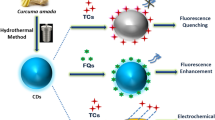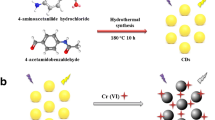Abstract
Carbon dots (CDs) with a diameter of 5.6 nm were synthesized from oxalic acid and tris base using a green, simple, and fast microwave synthesis method. The blue fluorescent CDs have remarkable features such as high-quantum yield, water-solubility, photoirradiation stability, and stability under various pH and ionic conditions. It was designed for application in three different areas. It was initially used as a fluorescence-based sensor for the detection of doxycycline with a LOD of 12 nM utilizing an IFE-based fluorescence quenching process. Second, with an outstanding LOD of 0.06 nM, it was utilized for mercuric ion sensing via electrochemical method. Third, the CDs were used as fluorescent ink for handwritten words and drawings without any pretreatment. Real sample analysis using the river and tap water samples confirmed its practicability in sensing applications.
Graphical abstract







Similar content being viewed by others
Data availability
All data generated or analyzed during this study are included in this published article (and its supplementary information files).
References
H. Liu, Y. Sun, J. Yang, Y. Hu, R. Yang, Z. Li, L. Qu, Y. Lin, High performance fluorescence biosensing of cysteine in human serum with superior specificity based on carbon dots and cobalt-derived recognition. Sens. Actuators B 280, 62–68 (2019)
W. Yang, H. Zhang, J. Lai, X. Peng, Y. Hu, W. Gu, L. Ye, Carbon dots with red-shifted photoluminescence by fluorine doping for optical bio-imaging. Carbon 128, 78–85 (2018)
Y. Zhou, E.M. Zahran, B.A. Quiroga, J. Perez, K.J. Mintz, Z. Peng, P.Y. Liyanage, R.R. Pandey, C.C. Chusuei, R.M. Leblanc, Size-dependent photocatalytic activity of carbon dots with surface-state determined photoluminescence. Appl. Catal. B 248, 157–166 (2019)
S. Ganguly, P. Das, S. Banerjee, N.C. Das, Advancement in science and technology of carbon dot-polymer hybrid composites: a review. Funct. Compos. Struct. 1(2), 022001 (2019)
J.O. Abdulsattar, H. Hadi, S. Richardson, A. Iles, N. Pamme, Detection of doxycycline hyclate and oxymetazoline hydrochloride in pharmaceutical preparations via spectrophotometry and microfluidic paper-based analytical device (μPADs). Anal. Chim. Acta 1136, 196–204 (2020)
V.G. da Silveira, M.S. Oliveira, C.A. de Almeida, R.B. Hoff, C.A. Mallmann, Liquid chromatography-tandem mass spectrometry determination and depletion profile of chlortetracycline, doxycycline, and oxytetracycline in broiler chicken muscle after oral administration. Food Anal. Methods 11(8), 2181–2194 (2018)
S. Palamy, W. Ruengsitagoon, A novel flow injection spectrophotometric method using plant extracts as green reagent for the determination of doxycycline. Spectrochim. Acta A 171, 200–206 (2017)
A. Ashuo, W. Zou, J. Fu, T. Yang, L. Yu, W. Liu, L. Yang, G.M. Mari, H. Jiang, High throughput detection of antibiotic residues in milk by time-resolved fluorescence immunochromatography based on QR code. Food Addit. Contam. A 37(9), 1481–1490 (2020)
T. Xia, T. Song, G. Zhang, Y. Cui, Y. Yang, Z. Wang, G. Qian, A terbium metal–organic framework for highly selective and sensitive luminescence sensing of Hg2+ ions in aqueous solution. Chem. A 22(51), 18429–18434 (2016)
Y. Li, H. Zhou, W. Chen, G. Sun, L. Sun, J. Su, A simple AIE-based chemosensor for highly sensitive and selective detection of Hg2+ and CN−. Tetrahedron 72(36), 5620–5625 (2016)
D. Siswanta, M. Kin, H. Hisamoto, K. Suzuki, Novel Hg2+ ionophores based on N-hydroxylamide derivatives as a sensory molecule for an ion-selective electrode. Chem. Lett. 1996(11), 1011–1012 (1996)
D.B. Bittar, D.S. Ribeiro, R.N. Páscoa, J.X. Soares, S.S.M. Rodrigues, R.C. Castro, L. Pezza, H.R. Pezza, J.L. Santos, Multiplexed analysis combining distinctly-sized CdTe-MPA quantum dots and chemometrics for multiple mutually interfering analyte determination. Talanta 174, 572–580 (2017)
G. Hu, J. Kang, L.W. Ng, X. Zhu, R.C. Howe, C.G. Jones, M.C. Hersam, T. Hasan, Functional inks and printing of two-dimensional materials. Chem. Soc. Rev. 47(9), 3265–3300 (2018)
M.R. Pacquiao, M.D.G. de Luna, N. Thongsai, S. Kladsomboon, P. Paoprasert, Highly fluorescent carbon dots from enokitake mushroom as multi-faceted optical nanomaterials for Cr6+ and VOC detection and imaging applications. Appl. Surf. Sci. 453, 192–203 (2018)
A. Barati, M. Shamsipur, H. Abdollahi, Carbon dots with strong excitation-dependent fluorescence changes towards pH. Application as nanosensors for a broad range of pH. Anal. Chim. Acta 931, 25–33 (2016)
Q. Huang, Q. Li, Y. Chen, L. Tong, X. Lin, J. Zhu, Q. Tong, High quantum yield nitrogen-doped carbon dots: green synthesis and application as “off-on” fluorescent sensors for the determination of Fe3+ and adenosine triphosphate in biological samples. Sens. Actuators B 276, 82–88 (2018)
R. Purbia, S. Paria, A simple turn on fluorescent sensor for the selective detection of thiamine using coconut water derived luminescent carbon dots. Biosens. Bioelectron. 79, 467–475 (2016)
V.N. Mehta, S. Jha, H. Basu, R.K. Singhal, S.K. Kailasa, One-step hydrothermal approach to fabricate carbon dots from apple juice for imaging of mycobacterium and fungal cells. Sens. Actuators B 213, 434–443 (2015)
V.N. Mehta, S. Jha, R.K. Singhal, S.K. Kailasa, Preparation of multicolor emitting carbon dots for HeLa cell imaging. New J. Chem. 38(12), 6152–6160 (2014)
A. Dager, T. Uchida, T. Maekawa, M. Tachibana, Synthesis and characterization of mono-disperse carbon quantum dots from fennel seeds: photoluminescence analysis using machine learning. Sci. Rep. 9(1), 1–12 (2019)
L.S. Li, X.Y. Jiao, Y. Zhang, C. Cheng, K. Huang, L. Xu, Highly fluorescent carbon dots synthesized with binary dopants for “turn off” and “turn off-on” sensing and cell imaging. Sens. Actuators B 268, 84–92 (2018)
Q. Li, Z. Bai, X. Xi, Z. Guo, C. Liu, X. Liu, X. Zhao, Z. Li, Y. Cheng, Y. Wei, Rapid microwave-assisted green synthesis of guanine-derived carbon dots for highly selective detection of Ag+ in aqueous solution. Spectrochim. Acta A 248, 119208 (2021)
N.R. Pires, C.M. Santos, R.R. Sousa, R. Paula, P.L. Cunha, J. Feitosa, Novel and fast microwave-assisted synthesis of carbon quantum dots from raw cashew gum. J. Braz. Chem. Soc. 26, 1274–1282 (2015)
S. Qian, W. Xu, K. Jiang, Y. Wang, H. Lin, An inner filter effect-based near-infrared probe for the ultrasensitive detection of tetracyclines and quinolones. Talanta 194, 598–603 (2019)
T.D. Gauthier, E.C. Shane, W.F. Guerin, W.R. Seitz, C.L. Grant, Fluorescence quenching method for determining equilibrium constants for polycyclic aromatic hydrocarbons binding to dissolved humic materials. Environ. Sci. Technol. 20(11), 1162–1166 (1986)
J.W. Zhou, X.M. Zou, S.H. Song, G.H. Chen, Quantum dots applied to methodology on detection of pesticide and veterinary drug residues. J. Agric. Food Chem. 66(6), 1307–1319 (2018)
J. Yu, K. Yuan, X. Li, R. Qin, L. Li, X. Yang, X. Yu, X. Zhang, Z. Lu, H. Liu, Selective detection for seven kinds of antibiotics with blue emitting carbon dots and Al3+ ions. Spectrochim. Acta A 223, 117366 (2019)
X. Fu, R. Lv, J. Su, H. Li, B. Yang, W. Gu, X. Liu, A dual-emission nano-rod MOF equipped with carbon dots for visual detection of doxycycline and sensitive sensing of MnO4−. RSC Adv. 8(9), 4766–4772 (2018)
X. Feng, J. Ashley, T. Zhou, Y. Sun, Fluorometric determination of doxycycline based on the use of carbon quantum dots incorporated into a molecularly imprinted polymer. Microchim. Acta 185(11), 1–9 (2018)
S. Huang, L. Yu, P. Su, T. Wen, M. Sun, D. Huang, X. Wang, S. Wang, Surface enhanced FRET for sensitive and selective detection of doxycycline using organosilicon nanodots as donors. Anal. Chim. Acta 1197, 339530 (2022)
Y. Zhang, H. Zhao, Z. Wu, Y. Xue, X. Zhang, Y. He, X. Li, Z. Yuan, A novel graphene-DNA biosensor for selective detection of mercury ions. Biosens. Bioelectron. 48, 180–187 (2013)
N. Chen, Y. Zhang, H. Liu, X. Wu, Y. Li, L. Miao, Z. Shen, A. Wu, High-performance colorimetric detection of Hg2+ based on triangular silver nanoprisms. ACS Sens. 1(5), 521–527 (2016)
R.K.B. Barvin, P. Prakash, V. Ganesh, B. Jeyaprabha, Highly selective and sensitive sensing of toxic mercury ions utilizing carbon quantum dot-modified glassy carbon electrode. Int. J. Environ. Res. 13(6), 1015–1023 (2019)
B.K. Korah, M.S. Punnoose, C.R. Thara, T. Abraham, K.G. Ambady, B. Mathew, Curcuma amada derived nitrogen-doped carbon dots as a dual sensor for tetracycline and mercury ions. Diam. Relat. Mater. 125, 108980 (2022)
A. Mao, H. Li, Z. Cai, X. Hu, Determination of mercury using a glassy carbon electrode modified with nano TiO2 and multi-walled carbon nanotubes composites dispersed in a novel cationic surfactant. J. Electroanal. Chem. 751, 23–29 (2015)
M.M. Radhi, W.T. Tan, M.Z.B. Ab Rahman, A.B. Kassim, Electrochemical redox of Hg2+ mediated by activated carbon modified glassy carbon electrode. Int. J. Electrochem. Sci. 5, 615–629 (2010)
J. Manioudakis, F. Victoria, C.A. Thompson, L. Brown, M. Movsum, R. Lucifero, R. Naccache, Effects of nitrogen-doping on the photophysical properties of carbon dots. J. Mater. Chem. C 7(4), 853–862 (2019)
F. Yan, Z. Sun, H. Zhang, X. Sun, Y. Jiang, Z. Bai, The fluorescence mechanism of carbon dots, and methods for tuning their emission color: a review. Microchim. Acta 186(8), 1–37 (2019)
H. Huang, J.J. Lv, D.L. Zhou, N. Bao, Y. Xu, A.J. Wang, J.J. Feng, One-pot green synthesis of nitrogen-doped carbon nanoparticles as fluorescent probes for mercury ions. RSC Adv. 3(44), 21691–21696 (2013)
L. Sciortino, A. Sciortino, R. Popescu, R. Schneider, D. Gerthsen, S. Agnello, M. Cannas, F. Messina, Tailoring the emission color of carbon dots through nitrogen-induced changes of their crystalline structure. J. Phys. Chem. C 122(34), 19897–19903 (2018)
R. Atchudan, T.N.J.I. Edison, K.R. Aseer, S. Perumal, N. Karthik, Y.R. Lee, Highly fluorescent nitrogen-doped carbon dots derived from Phyllanthus acidus utilized as a fluorescent probe for label-free selective detection of Fe3+ ions, live cell imaging and fluorescent ink. Biosens. Bioelectron. 99, 303–311 (2018)
L. Zhou, F. Wu, J. Yu, Q. Deng, F. Zhang, G. Wang, Titanium carbide (Ti3C2Tx) MXene: a novel precursor to amphiphilic carbide-derived graphene quantum dots for fluorescent ink, light-emitting composite and bioimaging. Carbon 118, 50–57 (2017)
H. Ma, C. Sun, G. Xue, G. Wu, X. Zhang, X. Han, X. Qi, X. Lv, H. Sun, J. Zhang, Facile synthesis of fluorescent carbon dots from Prunus cerasifera fruits for fluorescent ink, Fe3+ ion detection and cell imaging. Spectrochim. Acta A 213, 281–287 (2019)
Author information
Authors and Affiliations
Corresponding author
Ethics declarations
Conflict of interests
The authors declare that they have no known competing interests.
Supplementary Information
Below is the link to the electronic supplementary material.
Rights and permissions
Springer Nature or its licensor holds exclusive rights to this article under a publishing agreement with the author(s) or other rightsholder(s); author self-archiving of the accepted manuscript version of this article is solely governed by the terms of such publishing agreement and applicable law.
About this article
Cite this article
Korah, B.K., John, N., John, B.K. et al. Carbon dots as a fluorescent ink and dual-mode probe for the efficient detection of doxycycline and Hg(II) ions. Journal of Materials Research 37, 3060–3070 (2022). https://doi.org/10.1557/s43578-022-00711-1
Received:
Accepted:
Published:
Issue Date:
DOI: https://doi.org/10.1557/s43578-022-00711-1




